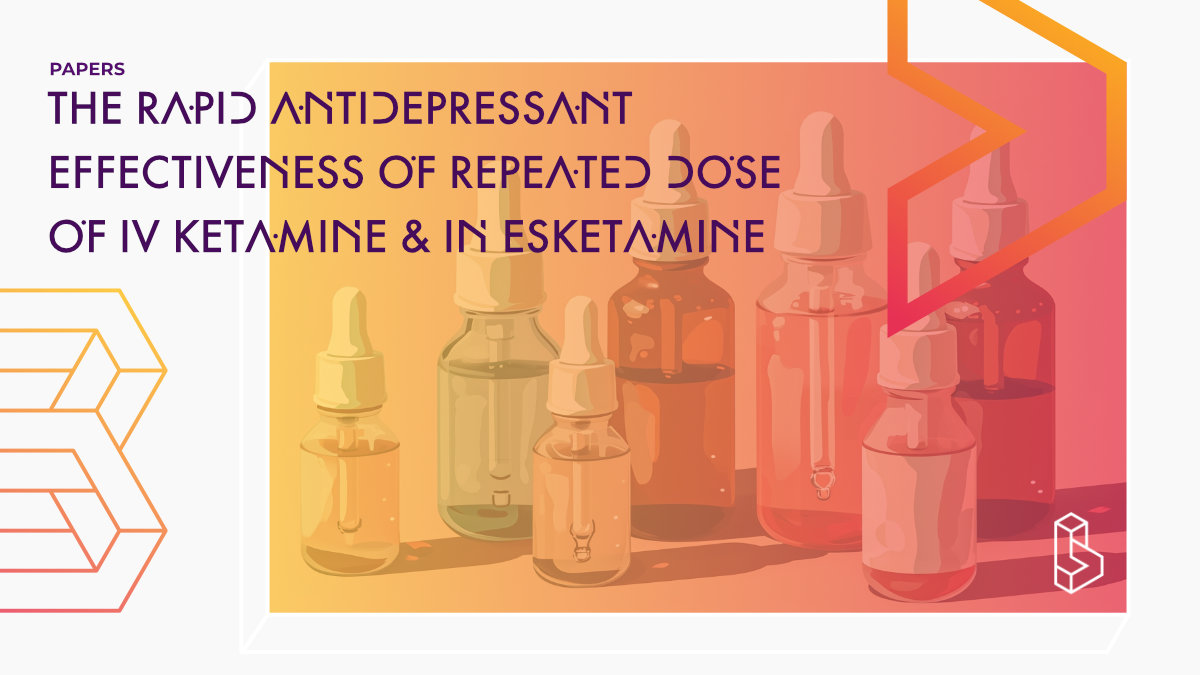This combined analysis of two cohorts (n=311) compared intravenous ketamine (KET-IV) and intranasal esketamine (ESK-NS) in the treatment of Treatment-Resistant Depression (TRD). The study found that KET-IV (n=171) had larger effect sizes and higher response rates than ESK-NS (n=140), although both significantly reduced depressive symptoms. Despite KET-IV having more reported side effects, its discontinuation rate due to adverse events was not significantly higher than ESK-NS.
Abstract of The rapid antidepressant effectiveness of repeated dose of intravenous ketamine and intranasal esketamine
“Introduction Intravenous ketamine (KET-IV) and intranasal esketamine (ESK-NS) are effective in the acute treatment of Treatment-Resistant Depression (TRD). Studies comparing KET-IV and ESK-NS concerning their action, safety, and tolerability are currently lacking.
Materials and methods We combined patients’ data from two unipolar TRD cohorts that received KET-IV (n = 171) at the Canadian Rapid Treatment Center of Excellence in Toronto, Canada, or ESK-NS (n = 140) at several TRD clinics in Italy. The Quick Inventory for Depression Symptomatology-Self-Report-16/QIDS-SR16 in the KET-IV group and Montgomery-Åsberg Depression Rating Scale/MADRS in the ESK-NS group measured depressive symptoms at baseline (T0) and after the acute treatment phase (T1) (i.e., four infusions of KET-IV and eight administrations of ESK-NS). As different scales were used, the primary outcome was to compare the improvement in depression severity in the two cohorts by measuring effect sizes, response and remission rates. Finally, we compare side effects and discontinuation rates.
Results At T1, KET-IV and ESK-NS significantly reduced depressive symptoms (respectively: QIDS-SR16 mean reduction = 5.65, p < 0.001; MADRS mean reduction = 11.41, p = 0.025). KET-IV showed larger effect sizes compared to ESK-NS (1.666 vs. 1.244). KET-IV had higher response rates (36 % vs. 25 %; p = 0.042) but not superior remission rates (13 % vs. 12 %; p = 0.845) than ESK-NS at T1. Despite more reported side effects, KET-IV did not cause more discontinuations for adverse events (4.6 % vs. 2.12 %; p = 0.228) than ESK-NS.
Conclusion KET-IV showed a higher short-term antidepressant effect, whereas ESK-NS exhibited lower side effects. Both were generally well tolerated. Future head-to-head studies should consider the long-term efficacy of these treatments.”
Authors: Giacomo d’Andrea, Mauro Pettorruso, Giorgio Di Lorenzo, Taeho Greg Rhee, Stefania Chiappini, Rosalba Carullo, Stefano Barlati, Raffaella Zanardi, Gianluca Rosso, Marco Di Nicola, Ileana Andriola, Matteo Marcatili, Massimo Clerici, Bernardo Maria Dell’Osso, Stefano L. Sensi, Rodrigo B. Mansur, Joshua D. Rosenblat, Giovanni Martinotti, Roger S. McIntyre
Summary of The rapid antidepressant effectiveness of repeated dose of intravenous ketamine and intranasal esketamine
Treatment-resistant Depression (TRD) is a severe and debilitating condition that imposes a significant disease burden and incurs substantial direct and indirect healthcare costs. Recent research efforts have focused mainly on Non-Invasive Brain Stimulation Techniques and on glutamatergic agents.
Ketamine and its S-enantiomer, esketamine, have emerged as established acute treatments for adults with TRD. They are also used in treatment-resistant bipolar depression and mixed-features symptoms, in patients with comorbid substance use, and in older adults.
Ketamine has shown significant antidepressant effects in various studies, but its use in routine clinical practice and approval by regulatory agencies has been limited. Intranasal esketamine (ESK-NS) has recently been approved by the FDA and EMA as the first specific therapy for TRD.
The existing empirical data comparing the effectiveness of ESK-NS and KET-IV remain relatively sparse, and meta-analytical examinations have demonstrated mixed results.
Find this paper
https://doi.org/10.1016/j.jad.2023.12.038
Paywall | Google Scholar | Backup | 🕊
Cite this paper (APA)
d'Andrea, G., Pettorruso, M., Di Lorenzo, G., Rhee, T. G., Chiappini, S., Carullo, R., ... & McIntyre, R. S. (2023). The rapid antidepressant effectiveness of repeated dose of intravenous ketamine and intranasal esketamine: A post-hoc analysis of pooled real-world data. Journal of Affective Disorders.
Study details
Compounds studied
Ketamine
Topics studied
Treatment-Resistant Depression
Depression
Study characteristics
Re-analysis
Participants
311
Humans

